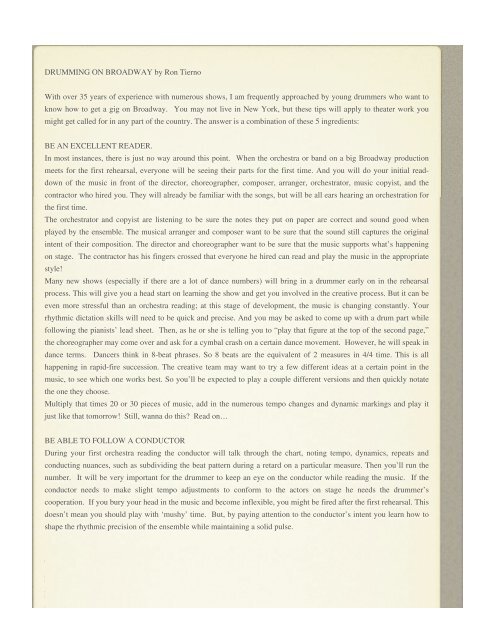You also want an ePaper? Increase the reach of your titles
YUMPU automatically turns print PDFs into web optimized ePapers that Google loves.
DRUMMING ON BROADWAY by Ron Tierno<br />
With over 35 years of experience with numerous shows, I am frequently approached by young drummers who want to<br />
know how to get a gig on Broadway. You may not live in New York, but these tips will apply to theater work you<br />
might get called for in any part of the country. The answer is a combination of these 5 ingredients:<br />
BE AN EXCELLENT READER.<br />
In most instances, there is just no way around this point. When the orchestra or band on a big Broadway production<br />
meets for the first rehearsal, everyone will be seeing their parts for the first time. And you will do your initial readdown<br />
of the music in front of the director, choreographer, composer, arranger, orchestrator, music copyist, and the<br />
contractor who hired you. They will already be familiar with the songs, but will be all ears hearing an orchestration for<br />
the first time.<br />
The orchestrator and copyist are listening to be sure the notes they put on paper are correct and sound good when<br />
played by the ensemble. The musical arranger and composer want to be sure that the sound still captures the original<br />
intent of their composition. The director and choreographer want to be sure that the music supports what’s happening<br />
on stage. The contractor has his fingers crossed that everyone he hired can read and play the music in the appropriate<br />
style!<br />
Many new shows (especially if there are a lot of dance numbers) will bring in a drummer early on in the rehearsal<br />
process. This will give you a head start on learning the show and get you involved in the creative process. But it can be<br />
even more stressful than an orchestra reading; at this stage of development, the music is changing constantly. Your<br />
rhythmic dictation skills will need to be quick and precise. And you may be asked to come up with a drum part while<br />
following the pianists’ lead sheet. Then, as he or she is telling you to “play that figure at the top of the second page,”<br />
the choreographer may come over and ask for a cymbal crash on a certain dance movement. However, he will speak in<br />
dance terms. Dancers think in 8-beat phrases. So 8 beats are the equivalent of 2 measures in 4/4 time. This is all<br />
happening in rapid-fire succession. The creative team may want to try a few different ideas at a certain point in the<br />
music, to see which one works best. So you’ll be expected to play a couple different versions and then quickly notate<br />
the one they choose.<br />
Multiply that times 20 or 30 pieces of music, add in the numerous tempo changes and dynamic markings and play it<br />
just like that tomorrow! Still, wanna do this? Read on…<br />
BE ABLE TO FOLLOW A CONDUCTOR<br />
During your first orchestra reading the conductor will talk through the chart, noting tempo, dynamics, repeats and<br />
conducting nuances, such as subdividing the beat pattern during a retard on a particular measure. Then you’ll run the<br />
number. It will be very important for the drummer to keep an eye on the conductor while reading the music. If the<br />
conductor needs to make slight tempo adjustments to conform to the actors on stage he needs the drummer’s<br />
cooperation. If you bury your head in the music and become inflexible, you might be fired after the first rehearsal. This<br />
doesn’t mean you should play with ‘mushy’ time. But, by paying attention to the conductor’s intent you learn how to<br />
shape the rhythmic precision of the ensemble while maintaining a solid pulse.<br />
Welcome<br />
Blank 60<br />
Blank 34<br />
Blank 33<br />
Blank 48


